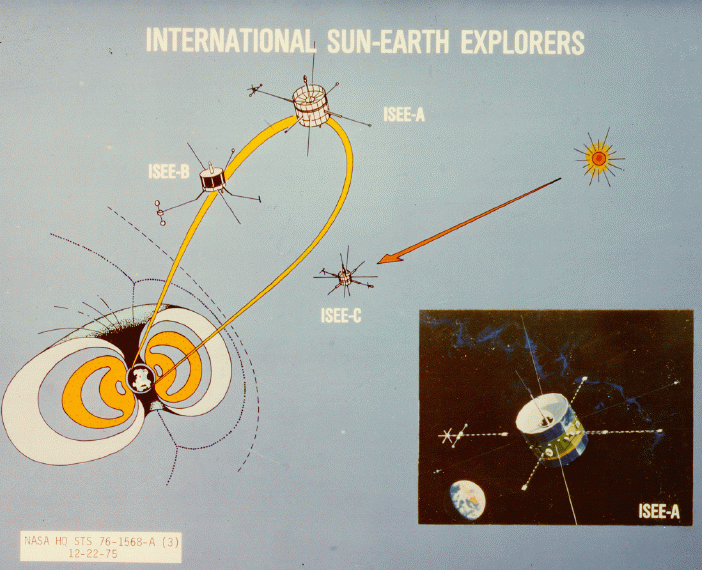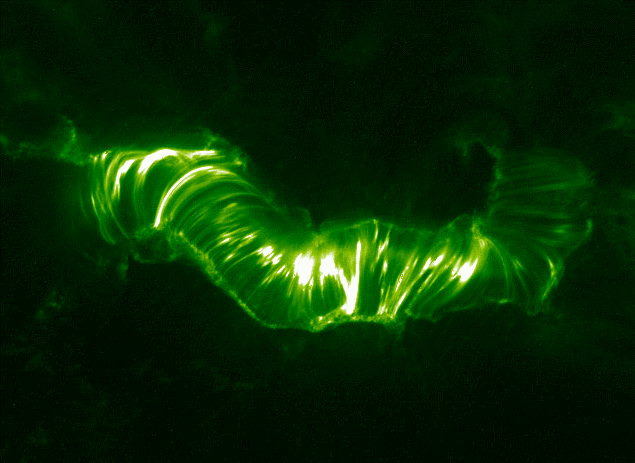|
ISEE-2
The ISEE-2 (International Sun-Earth Explorer-B or ISEE-B) was an Explorer-class daughter spacecraft, International Sun-Earth Explorer-2, was part of the mother/daughter/heliocentric mission (ISEE-1, ISEE-2, ISEE-3). ISEE-2 was a space probe used to study magnetic fields near the Earth. ISEE-2 was a spin-stabilized spacecraft and based on the design of the prior IMP (Interplanetary Monitoring Platform) series of spacecraft. ISEE-1 and ISEE-2 were launched on 22 October 1977, and they re-entered on 26 September 1987. The program was a cooperative mission between NASA and ESRO (later European Space Agency (ESA)), a memorandum of understanding (MOU) between NASA and the European Space Agency, was signed in March 1975. The program was designed to study the interaction between the Earth's magnetic field and the solar wind. At least 32 institutions were involved, and the focus was on understanding magnetic fields. ISEE-1 and ISEE-3 were built by NASA, while ISEE-2 was built by ESA. ... [...More Info...] [...Related Items...] OR: [Wikipedia] [Google] [Baidu] |
ISEE-1
The ISEE-1 (International Sun-Earth Explorer-A or ISEE-A) was an Explorer-class mother spacecraft, International Sun-Earth Explorer-1, was part of the mother/daughter/heliocentric mission (ISEE-1, ISEE-2, ISEE-3). ISEE-1 was a space probe used to study magnetic fields near the Earth. ISEE-1 was a spin-stabilized spacecraft and based on the design of the prior IMP ( Interplanetary Monitoring Platform) series of spacecraft. ISEE-1 and ISEE-2 were launched on 22 October 1977, and they re-entered on 26 September 1987. Mission The purposes of the mission were: (1) to investigate solar-terrestrial relationships at the outermost boundaries of the Earth's magnetosphere, (2) to examine in detail the structure of the solar wind near the Earth and the shock wave that forms the interface between the solar wind and the Earth's magnetosphere, (3) to investigate motions of and mechanisms operating in the plasma sheets, and (4) to continue the investigation of cosmic rays and solar f ... [...More Info...] [...Related Items...] OR: [Wikipedia] [Google] [Baidu] |
European Space Research Organisation
The European Space Research Organisation (ESRO) was an international organisation founded by 10 European nations with the intention of jointly pursuing scientific research in space. It was founded in 1964. As an organisation ESRO was based on a previously existing international scientific institution, CERN. The ESRO convention, the organisations founding document outlines it as an entity exclusively devoted to scientific pursuits. This was the case for most of its lifetime but in the final years before the formation of ESA, the European Space Agency, ESRO began a programme in the field of telecommunications. Consequently, ESA is not a mainly pure science focused entity but concentrates on telecommunications, earth observation and other application motivated activities. ESRO was merged with ELDO in 1975 to form the European Space Agency. [...More Info...] [...Related Items...] OR: [Wikipedia] [Google] [Baidu] |
ISEE Orbits , the statistics bureau of New Caledonia
{{disamb ...
The acronym ISEE can refer to: * ISEE (company), Integration Software Electronics Engineering * Independent School Entrance Examination *International Sun/Earth Explorer, one of a series of spacecraft, ISEE-1, ISEE-2 and ISEE-3, the last later called the International Cometary Explorer *International Society for Ecological Economics * International Society for Environmental Epidemiology *International Society for Environmental Ethics * International Society for Explosive Engineers *Institut national de la statistique et des études économiques, the national statistics bureau of France *Institute of Statistics and Economic Studies The Institute of Statistics and Economic Studies - New Caledonia (ISEE-NC) (french: link=no, italics=set, Institut de la Statistique et des Études Économiques-Nouvelle-Calédonie) is a public institution in New Caledonia ) , anthem = "" , i ... [...More Info...] [...Related Items...] OR: [Wikipedia] [Google] [Baidu] |
ISEE-3
The International Cometary Explorer (ICE) spacecraft (designed and launched as the International Sun-Earth Explorer-3 (ISEE-3) satellite), was launched 12 August 1978, into a heliocentric orbit. It was one of three spacecraft, along with the mother/daughter pair of ISEE-1 and ISEE-2, built for the International Sun-Earth Explorer (ISEE) program, a joint effort by NASA and ESRO/ESA to study the interaction between the Earth's magnetic field and the solar wind. ISEE-3 was the first spacecraft to be placed in a halo orbit at the Earth-Sun Lagrange point. Renamed ICE, it became the first spacecraft to visit a comet, passing through the plasma tail of comet Giacobini-Zinner within about of the nucleus on 11 September 1985. NASA suspended routine contact with ISEE-3 in 1997, and made brief status checks in 1999 and 2008. On 29 May 2014, two-way communication with the spacecraft was reestablished by the ISEE-3 Reboot Project, an unofficial group, with support from the Skycorp com ... [...More Info...] [...Related Items...] OR: [Wikipedia] [Google] [Baidu] |
Space Physics
Space physics, also known as solar-terrestrial physics or space-plasma physics, is the study of plasmas as they occur naturally in the Earth's upper atmosphere ( aeronomy) and within the Solar System. As such, it encompasses a far-ranging number of topics, such as heliophysics which includes the solar physics of the Sun, the solar wind, planetary magnetospheres and ionospheres, auroras, cosmic rays, and synchrotron radiation. Space physics is a fundamental part of the study of space weather and has important implications in not only to understanding the universe, but also for practical everyday life, including the operations of communications and weather satellites. Space physics is distinct from astrophysical plasma and the field of astrophysics, which studies similar plasma phenomena beyond the Solar System. Space physics utilizes in situ measurements from high altitude rockets and spacecraft, in contrast to astrophysical plasma that relies deduction of theory and astronomica ... [...More Info...] [...Related Items...] OR: [Wikipedia] [Google] [Baidu] |
Interplanetary Monitoring Platform
Interplanetary Monitoring Platform was a program managed by the NASA Goddard Space Flight Center in Greenbelt, Maryland, as part of the Explorers program, with the primary objectives of investigation of interplanetary plasma and the interplanetary magnetic field. The orbiting of IMP satellites in a variety of interplanetary and earth orbits allowed study of spatial and temporal relationships of geophysical and interplanetary phenomena simultaneously by several other NASA satellites. Satellites Technology The IMP program was the first space program to use integrated circuit (IC) chips, which it first launched into space with the IMP-A ( Explorer 18) in 1963. This predates the use of IC chips in the Apollo Guidance Computer, used for the Apollo program. The MOSFET (metal-oxide-semiconductor field-effect transistor, or MOS transistor) was adopted by NASA for the IMP program in 1964. The use of MOSFETs was a major step forward in spacecraft electronics design. The IMP-D ( Explor ... [...More Info...] [...Related Items...] OR: [Wikipedia] [Google] [Baidu] |
Plasma (physics)
Plasma ()πλάσμα , Henry George Liddell, Robert Scott, ''A Greek English Lexicon'', on Perseus is one of the four fundamental states of matter. It contains a significant portion of charged particles – ions and/or s. The presence of these charged particles is what primarily sets plasma apart from the other fundamental states of matter. It is the most abundant form of [...More Info...] [...Related Items...] OR: [Wikipedia] [Google] [Baidu] |
Astronomical Unit
The astronomical unit (symbol: au, or or AU) is a unit of length, roughly the distance from Earth to the Sun and approximately equal to or 8.3 light-minutes. The actual distance from Earth to the Sun varies by about 3% as Earth orbits the Sun, from a maximum ( aphelion) to a minimum ( perihelion) and back again once each year. The astronomical unit was originally conceived as the average of Earth's aphelion and perihelion; however, since 2012 it has been defined as exactly (see below for several conversions). The astronomical unit is used primarily for measuring distances within the Solar System or around other stars. It is also a fundamental component in the definition of another unit of astronomical length, the parsec. History of symbol usage A variety of unit symbols and abbreviations have been in use for the astronomical unit. In a 1976 resolution, the International Astronomical Union (IAU) had used the symbol ''A'' to denote a length equal to the ast ... [...More Info...] [...Related Items...] OR: [Wikipedia] [Google] [Baidu] |
Interplanetary Medium
The interplanetary medium (IPM) or interplanetary space consists of the mass and energy which fills the Solar System, and through which all the larger Solar System bodies, such as planets, dwarf planets, asteroids, and comets, move. The IPM stops at the heliopause, outside of which the interstellar medium begins. Before 1950, interplanetary space was widely considered to either be an empty vacuum, or consisting of "aether". Composition and physical characteristics The interplanetary medium includes interplanetary dust, cosmic rays, and hot plasma from the solar wind. The temperature of the interplanetary medium varies. For dust particles within the asteroid belt, typical temperatures range from 200 K (−73 °C) at 2.2 AU down to 165 K (−108 °C) at 3.2 AU. The density of the interplanetary medium is very low, decreasing in inverse proportion to the square of the distance from the Sun. It is variable, and may be affected by magnetic fields and e ... [...More Info...] [...Related Items...] OR: [Wikipedia] [Google] [Baidu] |
Solar Flare
A solar flare is an intense localized eruption of electromagnetic radiation in the Sun's atmosphere. Flares occur in active regions and are often, but not always, accompanied by coronal mass ejections, solar particle events, and other solar phenomena. The occurrence of solar flares varies with the 11-year solar cycle. Solar flares are thought to occur when stored magnetic energy in the Sun's atmosphere accelerates charged particles in the surrounding plasma. This results in the emission of electromagnetic radiation across the electromagnetic spectrum. High-energy electromagnetic radiation from solar flares is absorbed by the daylight side of Earth's upper atmosphere, in particular the ionosphere, and does not reach the surface. This absorption can temporarily increase the ionization of the ionosphere which may interfere with short-wave radio communication. The prediction of solar flares is an active area of research. Flares also occur on other stars, where the term ... [...More Info...] [...Related Items...] OR: [Wikipedia] [Google] [Baidu] |
Cosmic Ray
Cosmic rays are high-energy particles or clusters of particles (primarily represented by protons or atomic nuclei) that move through space at nearly the speed of light. They originate from the Sun, from outside of the Solar System in our own galaxy, and from distant galaxies. Upon impact with Earth's atmosphere, cosmic rays produce showers of secondary particles, some of which reach the surface, although the bulk is deflected off into space by the magnetosphere or the heliosphere. Cosmic rays were discovered by Victor Hess in 1912 in balloon experiments, for which he was awarded the 1936 Nobel Prize in Physics. Direct measurement of cosmic rays, especially at lower energies, has been possible since the launch of the first satellites in the late 1950s. Particle detectors similar to those used in nuclear and high-energy physics are used on satellites and space probes for research into cosmic rays. Data from the Fermi Space Telescope (2013) have been interpreted as evi ... [...More Info...] [...Related Items...] OR: [Wikipedia] [Google] [Baidu] |
Magnetosphere
In astronomy and planetary science, a magnetosphere is a region of space surrounding an astronomical object in which charged particles are affected by that object's magnetic field. It is created by a celestial body with an active interior dynamo. In the space environment close to a planetary body, the magnetic field resembles a magnetic dipole. Farther out, field lines can be significantly distorted by the flow of electrically conducting plasma, as emitted from the Sun (i.e., the solar wind) or a nearby star. Planets having active magnetospheres, like the Earth, are capable of mitigating or blocking the effects of solar radiation or cosmic radiation, that also protects all living organisms from potentially detrimental and dangerous consequences. This is studied under the specialized scientific subjects of plasma physics, space physics and aeronomy. History Study of Earth's magnetosphere began in 1600, when William Gilbert discovered that the magnetic field on the surfac ... [...More Info...] [...Related Items...] OR: [Wikipedia] [Google] [Baidu] |







